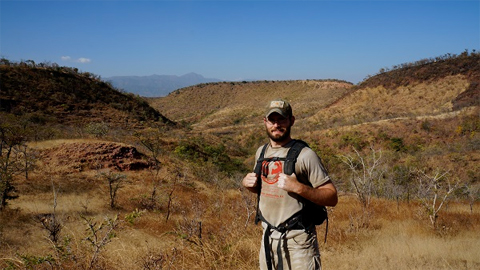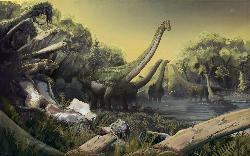
Eric Gorscak, lead author on the new study, is a Cambridge, Ohio, native who is a doctoral student in biological sciences at Ohio University. Photo: Emily R. Naylor/Courtesy of Eric Gorscak
In an article published last week in the Journal of Vertebrate Paleontology, Ohio University paleontologists have identified a new species of titanosaurian dinosaur. The new species is a member of the gigantic long-neck sauropods, and its fossil remains were recovered from Cretaceous-age (70-100 million years ago) rocks in southwestern Tanzania. Titanosaurs are known from all over the world and best known from South America, but fossils of this group are particularly rare from the African continent.

Ohio University paleontologists have identified a new species of titanosaurian dinosaur. Illustration by: Mark Witton
The new dinosaur is named Shingopana songwensis, a name derived from the Swahili expression for ‘wide neck’ and the Songwe region of the Great Rift Valley in southwestern Tanzania. Part of the Shingopana skeleton was first excavated in 2002 and represents the first significant discovery by the Rukwa Rift Basin Project, an international collaborative effort led by Ohio University Heritage College of Osteopathic Medicine professors Drs. Patrick O’Connor and Nancy Stevens. Over the next few years of excavation, additional portions of the skeleton, including neck vertebrae, ribs, a humerus, and part of the lower jaw, were recovered.
“There are a couple of key anatomical features only present in Shingopana and several South American titanosaurs but that are absent in other African titanosaurs,” said lead author Dr. Eric Gorscak, a recent Ph.D. graduate of Ohio University who earned a B.S. in Biological Sciences in 2009 and is now post-doctoral researcher at the Field Museum of Natural History in Chicago. “Shingopana had siblings in South America, whereas the other African titanosaurs were only distant cousins,” noted Gorscak.
Detailed comparison of Shingopana with other known sauropod dinosaurs suggests that the species found in southern Africa are certainly more diverse than previously thought. The team conducted phylogenetic analyses in order to understand the evolutionary relationships of these and other known titanosaurs. What they discovered is that Shingopana was more closely related to titanosaurs of South America than to any of the other species currently known from Africa or elsewhere.
“This discovery suggests that the fauna of northern and southern Africa were different in the Cretaceous,” says Judy Skog, program director in the National Science Foundation (NSF)’s Division of Earth Sciences, which supported the research. “At that time, Southern African dinosaurs were more closely related to those in South America, and were more widespread than we knew.”
During the Cretaceous, Shingopana roamed the landscape alongside Rukwatitan bisepultus, another titanosaur the same team described and named in 2014. Gorscak studied both skeletons as part of his dissertation research. He is one of three Ph.D. researchers to have completed the doctoral research on the Rukwa Rift Basin Project in the past year.
“We are still only scratching the surface with regard to understanding the diversity of organisms and the environments in which they lived on the African continent during the Late Cretaceous,” commented O’Connor, professor of anatomy at Ohio University and Gorscak’s adviser during his Ph.D. research. “And getting students involved in research and encouraging them to develop their own projects is one sure way of better addressing this knowledge gap.”
The authors note that there appears to be a division between northern and southern African biotas during the tectonically active Cretaceous Period. Southern Africa first experienced Madagascar and Antarctica splitting off to the east and south, followed by a gradual northward ‘unzipping’ from South America. All the while northern Africa maintained a land connection with South America, as southern Africa progressively became more isolated until the two continents completely separated 95-105 million years ago. Other factors such as terrain and climate may have further isolated southern Africa.
Co-author Eric Roberts, Head of Geosciences at James Cook University of Australia, studied the geological and paleoenvironmental context of the new discovery. Interestingly, the bones of Shingopana were damaged by borings produced by ancient insects shortly after the death of the animal. Roberts noted that “the presence of bone-borings provides a CSI-like opportunity to study the skeleton and reconstruct the timing of death and burial, as well as providing rare evidence for ancient insects and complex food webs during the age of dinosaurs.
The study was funded by the National Science Foundation, the National Geographic Society, the Jurassic Foundation, The Paleontological Society, Ohio University Student Enhancement Award, Ohio University Original Work Grant, the Ohio University Heritage College of Osteopathic Medicine, the Ohio University Office of the Vice President for Research and Creative Activity, and James Cook University.

















Comments